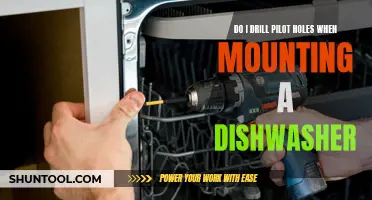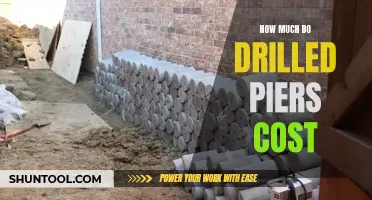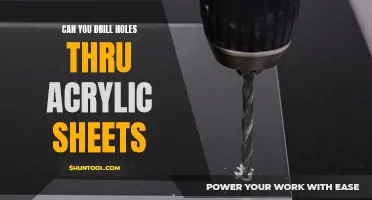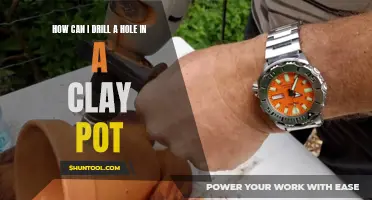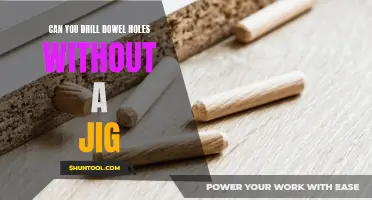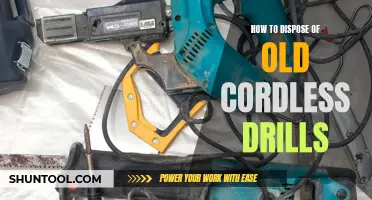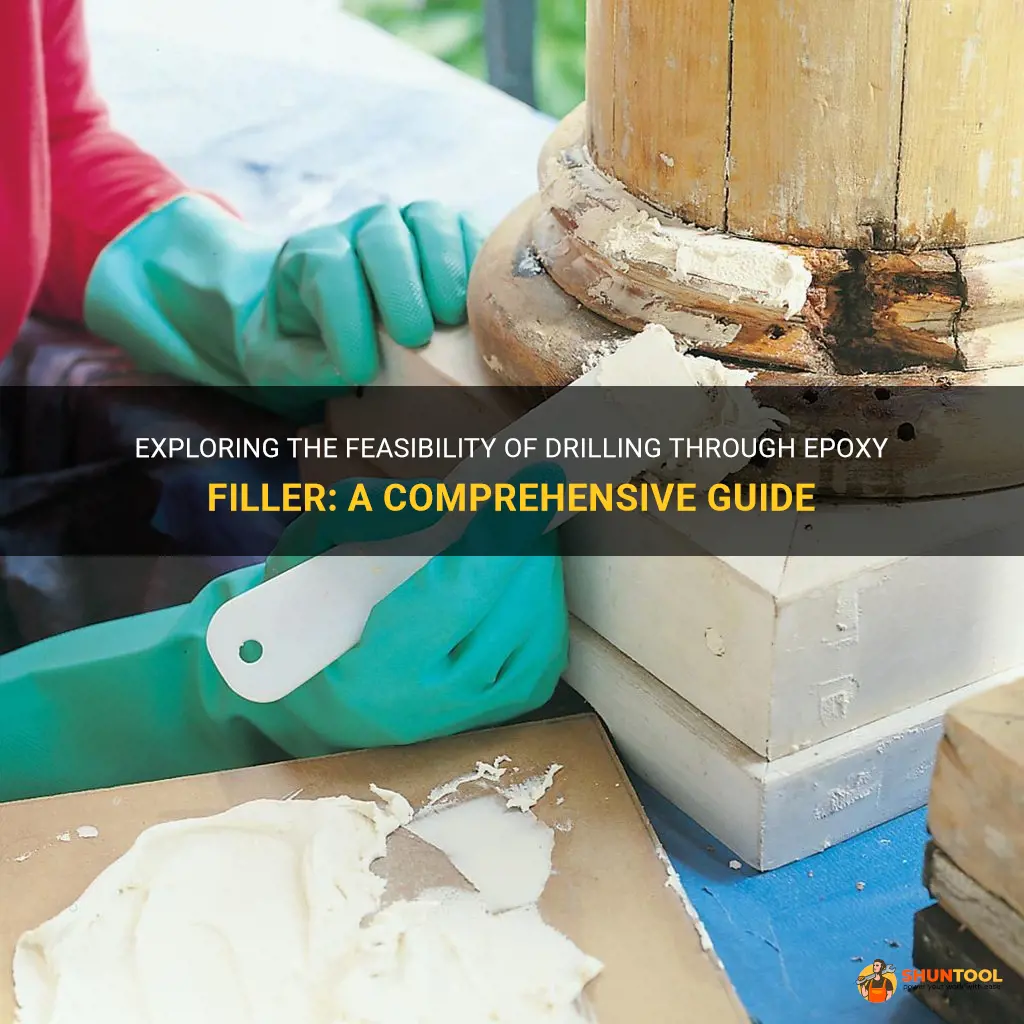
Have you ever wondered if you can drill through epoxy filler or hole filler putty? Well, you're not alone. Both epoxy filler and hole filler putty are commonly used to repair damaged surfaces or fill in holes. However, drilling through these materials can be tricky and may require some special techniques. In this article, we will explore the possibilities of drilling through epoxy filler and hole filler putty and provide some tips to successfully complete the task. So, if you've been pondering the possibility of drilling through these materials, keep reading to find out how it can be done!
What You'll Learn
- Can you drill through epoxy filler without damaging the surrounding area?
- What type of drill bit should be used when drilling through epoxy filler?
- Can you drill through epoxy filler with a hand drill, or is a power drill required?
- Are there any special precautions that need to be taken when drilling through epoxy filler?
- Will drilling through epoxy filler affect the structural integrity of the material?

Can you drill through epoxy filler without damaging the surrounding area?
Epoxy fillers are commonly used in various applications such as automotive repairs, construction, and crafts. They are widely known for their high-strength bond and resistance to chemicals and heat. However, there may be instances where you need to drill through epoxy filler without damaging the surrounding area. This article will provide you with step-by-step instructions on how to do it effectively.
Gather the necessary materials:
- Epoxy-filled surface
- Drill
- Drill bits (preferably carbide-tipped)
- Masking tape or painter's tape
- Safety goggles
- Dust mask
- Water spray bottle
Prepare the area:
Before starting, ensure that the surrounding area is adequately protected by covering it with masking tape or painter's tape. This will prevent any accidental scratches or damage.
Choose the right drill bit:
For drilling through epoxy filler, it is recommended to use carbide-tipped drill bits. These drill bits are specifically designed to withstand the hardness of epoxy materials and provide cleaner and more precise holes.
Mark the drilling spot:
Using a marker or pencil, mark the spot where you will drill the hole. This will serve as a guide and help you maintain accuracy during the drilling process.
Wear safety gear:
Put on your safety goggles to protect your eyes from any flying debris. Additionally, wear a dust mask to avoid inhaling the dust particles generated during drilling.
Start drilling:
Hold the drill perpendicular to the epoxy-filled surface and apply light pressure. Start drilling at a slow speed to ensure control and accuracy. Avoid excessive pressure as it can cause the drill bit to become embedded in the epoxy filler or damage the surrounding area.
Maintain a steady speed:
Drill through the epoxy filler using a steady speed. Avoid applying excessive force, as it can cause the epoxy to chip or crack. If you encounter resistance, it may be necessary to switch to a lower drill speed or use a larger drill bit.
Cool the drill bit:
To prevent overheating, periodically spray water onto the drill bit. This will help to dissipate heat and keep the drill bit from dulling prematurely.
Remove the drill bit:
Once you have drilled through the epoxy filler, remove the drill bit slowly to avoid any sudden movements that could cause damage. Clean off any epoxy residue on the drill bit before proceeding.
Inspect the drilled hole:
Inspect the drilled hole to ensure it meets your requirements. If necessary, you can use a sanding block to smooth out any rough edges or imperfections.
By following these steps, you can successfully drill through epoxy filler without damaging the surrounding area. Remember to take your time, use the right tools, and prioritize safety. Whether you are repairing a damaged surface or working on a creative project, drilling through epoxy filler can be accomplished with precision and care.
Choosing the Right Drill Hole Size for an 8-32 Tap: A Complete Guide
You may want to see also

What type of drill bit should be used when drilling through epoxy filler?
Epoxy fillers are commonly used to repair or fill gaps in various materials, such as wood, metal, or plastic. When it comes to drilling through epoxy filler, you'll need to choose the right type of drill bit to ensure a clean and effective hole.
There are a few different types of drill bits that can be used for drilling through epoxy filler, each with its own advantages and disadvantages. The most common options include twist drill bits, spade drill bits, and forstner drill bits.
Twist drill bits are the most versatile and widely used drill bits. They have a sharp, spiral-like cutting edge that allows them to penetrate various materials, including epoxy filler. Twist drill bits are typically made of high-speed steel (HSS) or cobalt steel, both of which are strong and durable. They are available in different sizes and can be used with both hand drills and power drills.
When using a twist drill bit to drill through epoxy filler, it's important to use a slow speed and apply gentle pressure. This will prevent the epoxy filler from cracking or chipping. Start by marking the desired location of the hole and ensuring that the material is securely clamped or supported. Then, position the drill bit at a right angle to the surface and slowly start drilling. It's recommended to use coolant or lubricant during the drilling process to reduce heat and friction.
Spade drill bits, also known as paddle or flat bits, are another option for drilling through epoxy filler. These drill bits have a flat, paddle-like tip with a sharp central point. The wide shape of the spade drill bit allows for quick and efficient drilling, making it suitable for larger holes. However, they may not provide the cleanest or most accurate results compared to twist drill bits.
Forstner drill bits are designed specifically for drilling flat-bottomed holes with smooth sides. They have a cylindrical shank and a sharp, cutting rim that bores through the material smoothly. Forstner drill bits are ideal for drilling precise holes in epoxy filler, such as for installing hardware or creating decorative accents. However, they are often available in larger sizes and may not be suitable for drilling smaller diameter holes.
In addition to the type of drill bit, it's also important to consider the size and hardness of the epoxy filler. Thicker or harder epoxy fillers may require larger or more durable drill bits to ensure successful drilling. It's always recommended to start with a smaller drill bit and gradually increase the size if needed, especially when drilling larger holes.
To summarize, when drilling through epoxy filler, twist drill bits are the most versatile option, while spade drill bits and forstner drill bits offer specific advantages for certain applications. Choose the appropriate drill bit based on the size and hardness of the epoxy filler, and use slow speeds and gentle pressure to prevent cracking or chipping. Follow these guidelines, and you'll be able to drill through epoxy filler effectively and efficiently.
Selecting the Perfect Hole Size for Mounting a BNC Security Camera
You may want to see also

Can you drill through epoxy filler with a hand drill, or is a power drill required?
Epoxy filler is a versatile material commonly used for various applications, such as filling cracks or holes in wood or metal surfaces. However, there may come a time when you need to drill through epoxy filler, whether it's to create a new hole or to access the underlying material. In these situations, you may wonder if a hand drill is sufficient or if a power drill is required. Let's delve into this question and explore the different factors to consider.
Firstly, it's important to understand the composition of epoxy filler. Epoxy fillers are typically made up of two components – a resin and a hardener – that combine to form a durable and strong material. Once the epoxy filler cures, it becomes quite hard and resistant to drilling. Consequently, drilling through epoxy filler requires a certain level of power and force to penetrate its surface effectively.
While it is possible to use a hand drill to drill through epoxy filler, a power drill is generally recommended for several reasons.
Power drills offer higher speeds and torque, allowing for smoother and more efficient drilling. The extra power generated by a power drill helps to overcome the resistance offered by the cured epoxy filler. Additionally, power drills often have adjustable speed settings, which can be beneficial when drilling through epoxy filler as it allows for better control over the drilling process.
When using a power drill, it is crucial to select the appropriate drill bit. For drilling through epoxy filler, carbide-tipped or diamond-coated drill bits are highly recommended. These types of drill bits are designed specifically for drilling through hard materials like epoxy and will help prevent excessive heat buildup during drilling. The heat generated can cause the epoxy to melt and stick to the drill bit, leading to less efficient drilling and potential damage to the epoxy filler.
To drill through epoxy filler using a power drill, follow these steps:
- Ensure you have the correct drill bit for the job, such as a carbide-tipped or diamond-coated drill bit.
- Mark the spot where you wish to drill using a pencil or marker.
- Secure the material with epoxy filler, if applicable, to prevent any movement during drilling.
- Attach the appropriate drill bit to your power drill and tighten it securely.
- Set the drill to the desired speed, typically a medium speed is suitable for drilling through epoxy filler.
- Position the drill bit on the marked spot and apply gentle pressure to initiate the drilling process.
- Gradually increase the pressure while maintaining a steady speed until the drill bit penetrates the epoxy filler.
- Continue drilling through the epoxy filler with steady pressure until you reach the desired depth.
Throughout the drilling process, it's important to exercise caution and wear appropriate protective equipment, such as safety glasses and gloves. It is also advisable to periodically withdraw the drill bit to remove any built-up epoxy residue on the bit, allowing for smoother and more efficient drilling.
In conclusion, while it is technically possible to drill through epoxy filler using a hand drill, a power drill is generally recommended for better results. The extra power, speed, and torque provided by a power drill make the drilling process smoother and more efficient. By choosing the correct drill bit, exercising caution, and following the proper drilling techniques, you can successfully drill through epoxy filler and achieve the desired outcome.
Exploring the Feasibility of Drilling Through PVC: What Every DIY Enthusiast Should Know
You may want to see also

Are there any special precautions that need to be taken when drilling through epoxy filler?
If you need to drill through epoxy filler, there are some special precautions you should take to ensure a successful and safe drilling process. Epoxy fillers are commonly used in a variety of applications, from repairing damaged surfaces to creating strong bonds between materials. However, drilling through epoxy poses some unique challenges that require careful consideration. By following the proper procedures and taking the necessary precautions, you can ensure a clean and precise drilling job without damaging the epoxy or compromising its structural integrity.
Choose the Right Drill Bit:
When drilling through epoxy filler, it is essential to use the appropriate drill bit for the job. Standard multipurpose drill bits may not be able to handle the hard and brittle nature of epoxy. Instead, opt for a carbide-tipped masonry drill bit or a specialized epoxy drill bit. These drill bits are designed to effectively and efficiently cut through epoxy without causing excessive heat or chipping.
Wear Protective Gear:
Always wear appropriate personal protective equipment (PPE) when drilling through epoxy filler. This includes safety goggles, a dust mask, and gloves. The epoxy dust created during drilling can be harmful if inhaled, and the shards of epoxy may cause eye or skin irritation. Therefore, it is crucial to protect your eyes, respiratory system, and skin from potential hazards.
Mark the Drill Hole:
Before drilling, mark the center of the drill hole on the epoxy surface using a pencil or a fine-tip marker. This step ensures that the drill bit is properly aligned and prevents accidental mistakes or drilling outside the intended area. Double-check the marked spot to ensure it is in the desired location.
Start Slowly:
When you begin drilling, start at a slow speed to allow the drill bit to penetrate the epoxy gradually. Applying excessive force can cause the epoxy to crack or chip, resulting in an uneven and messy hole. Slow and steady progress is key to achieving a clean and well-formed hole without compromising the structural integrity of the epoxy filler.
Use Cooling Techniques:
Drilling through epoxy can generate heat, which can affect the integrity of the material and the surrounding area. To prevent overheating, consider using cooling techniques during the drilling process. You can use a water spray bottle to cool down the drill bit periodically or apply a lubricant specially designed for drilling into epoxy fillers. These cooling methods help reduce heat build-up and increase the lifespan of the drill bit.
Clean the Hole:
Once you have drilled through the epoxy filler, it is important to clean the hole thoroughly. Use a brush or compressed air to remove any loose epoxy debris from the hole. This will ensure a proper fit for any fasteners or components that need to be inserted into the drilled hole. Cleanliness is crucial for achieving a secure and durable connection.
In conclusion, drilling through epoxy filler requires some specific precautions to ensure a successful outcome. By choosing the right drill bit, wearing protective gear, marking the drill hole, starting slowly, using cooling techniques, and cleaning the hole, you can drill through epoxy without damaging its structural integrity. Following these guidelines will help you achieve precise and clean holes while maintaining the integrity of the epoxy filler. Always remember to prioritize safety and take the necessary precautions to protect yourself when working with epoxy fillers.
Finding the Perfect Hole Size for Installing 5/16 Nut Serts
You may want to see also

Will drilling through epoxy filler affect the structural integrity of the material?
Epoxy filler is a versatile material often used for repairing and filling cracks and gaps in various surfaces such as wood, concrete, and metal. However, when it comes to drilling through epoxy filler, concerns may arise regarding the structural integrity of the material. In this article, we will explore whether drilling through epoxy filler can have any negative effects on its strength and durability.
To understand the potential impact of drilling through epoxy filler, it is important to first understand the properties and composition of epoxy. Epoxy is a type of synthetic resin that is formed by the chemical reaction between an epoxy resin and a curing agent. This reaction creates a strong, rigid, and highly adhesive material that can bond well with a wide range of surfaces.
When drilling through epoxy filler, it is essential to consider the thickness and completeness of the epoxy layer. If the epoxy filler is applied correctly and well-cured, it should have a uniform thickness and a strong bond with the surrounding material. In such cases, drilling through the epoxy filler should not significantly affect its structural integrity.
However, if the epoxy filler is improperly mixed, insufficiently cured, or applied in an inconsistent manner, its structural integrity may be compromised. In such cases, drilling through the epoxy filler could result in cracks, delamination, or weakening of the material.
It is also important to consider the type and size of the drilling operation. Drilling small holes through epoxy filler, for example, for inserting screws or fasteners, is generally unlikely to cause any significant damage to the epoxy or the underlying material. However, larger holes or more aggressive drilling operations may weaken the epoxy filler and affect its ability to provide structural support.
To minimize the risk of compromising the structural integrity of epoxy filler when drilling through it, it is recommended to follow these steps:
- Evaluate the thickness and completeness of the epoxy filler layer. If the epoxy layer appears uniform and well-cured, it is likely to have good structural integrity.
- Use the correct drilling tools and techniques. Using sharp drill bits specifically designed for drilling through epoxy materials can reduce the risk of creating cracks or delamination.
- Start with a pilot hole. When drilling larger holes, it is advisable to first create a smaller pilot hole to guide the drill bit and reduce the strain on the epoxy filler.
- Keep the drilling speed and pressure moderate. Applying excessive force during drilling can cause the epoxy filler to crack or delaminate. A steady and controlled drilling process should be employed.
- Inspect the drilled area carefully. After drilling through the epoxy filler, visually inspect the area for any signs of damage or weakness. If any concerns arise, further evaluation and possible repairs may be necessary.
In conclusion, drilling through epoxy filler does have the potential to affect its structural integrity, depending on factors such as the quality of the epoxy application and the size and type of drilling operation. However, when done correctly with care and adherence to recommended techniques, drilling through epoxy filler should not significantly compromise its strength and durability.
Drilling into a Surface Plate: What You Need to Know
You may want to see also
Frequently asked questions
Yes, you can drill through epoxy filler. Epoxy fillers are commonly used to patch holes or cracks in various materials such as wood, metal, or concrete. Once the epoxy filler has fully cured and hardened, it becomes a strong and durable material that can be drilled, sanded, or even painted over.
When drilling through epoxy filler, it is best to use a drill bit specifically designed for drilling through hard materials such as metal or concrete. Carbide or diamond-tipped drill bits are highly recommended for drilling through epoxy filler as they are extremely durable and can easily penetrate the hardened material without chipping or breaking.
While drilling through epoxy filler is generally straightforward, there are a few techniques that can help ensure a clean and precise hole. It is important to securely hold the drill and apply steady, even pressure throughout the drilling process. Using a low speed setting on the drill can also help prevent overheating or causing the epoxy filler to crack or chip.
Yes, if you need to fill the drilled hole with epoxy filler, you can certainly do so. Simply clean out any debris or dust from the hole, mix the epoxy filler according to the manufacturer's instructions, and carefully fill the hole with the epoxy mixture. Allow the epoxy filler to fully cure and harden before sanding or painting over it to achieve a smooth and seamless finish.


